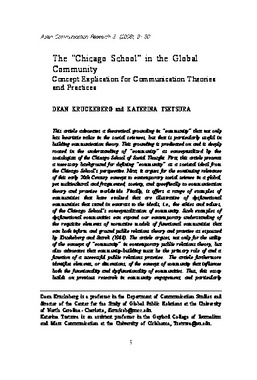| dc.contributor.author | Tsetsura, Katerina | |
| dc.creator | Kruckeberg, Dean | |
| dc.date.accessioned | 2017-12-19T16:41:23Z | |
| dc.date.available | 2017-12-19T16:41:23Z | |
| dc.date.issued | 2008 | |
| dc.identifier.citation | Kruckeberg & Tsetsura. (2008). The "Chicago School" in the Global Community. Asian Communication Research, 5(1), 9-30. | |
| dc.identifier.issn | 1738-2084 | |
| dc.identifier.uri | https://hdl.handle.net/11244/54168 | |
| dc.description.abstract | This article advocates a theoretical grounding in "community" that not only has heuristic value in the social sciences, but that is particularly useful in building communication theory. This grounding is predicated on and is deeply rooted in the understanding of "community" as conceptualized by the sociologists of the Chicago School of Social Thought. First, this article presents a necessary background for defining "community" as a societal ideal from the Chicago School's perspective. Next, it argues for the continuing relevance of this early 20th Century concept to contemporary social science in a global, yet multicultural and fragmented, society, and specifically to communication theory and practice worldwide. Finally, it offers a range of examples of communities that have evolved that are illustrative of dysfunctional communities that stand in contrast to the ideals, i.e., the ethics and values, of the Chicago School's conceptualization of community. Such examples of dysfunctional communities can expand our contemporary understanding of the requisite elements of normative models of functional communities that can both inform and ground public relations theory and practice as espoused by Kruckeberg and Starck (1988). The article argues, not only for the utility of the concept of "community" in contemporary public relations theory, but also advocates that community-building must be the primary role of and a function of a successful public relations practice. The article furthermore identifies elements, or dimensions, of the concept of community that influence both the functionality and dysfunctionality of communities. Thus, this essay builds on previous research in community engagement, and particularly communication and public relations (e.g., Barbaro, 2006; Ramrez, Aitkin, & Kora, 2005; Kruckeberg & Starck, 1988; Starck & Kruckeberg, 2001) and extends a meta theoretical framework of community in relation to community-building to continue to inform communication theory-building by providing a typology of communities together with constitutive and operational criteria of both functional and dysfunctional communities — a categorization that has both theoretical and practical implications. | |
| dc.description.sponsorship | Korean Society for Journalism and Communication Studies | |
| dc.format.extent | 22 pages | |
| dc.format.extent | 307,637 bytes | |
| dc.format.medium | application.pdf | |
| dc.language | en_US | |
| dc.publisher | Korean Society for Journalism and Communication Studies (KSJCS) | |
| dc.relation.ispartofseries | Vol. 5, No. 1 | |
| dc.relation.uri | https://www.comm.or.kr/EJournal/Home/Index/3 | |
| dc.subject | Community-Building | |
| dc.subject | Public Relations | |
| dc.subject | Chicago School | |
| dc.subject | Disfunctional / Functional Community | |
| dc.subject | Typology of Communities | |
| dc.title | The "Chicago School" in the global community: concept explication for communication theories and practices | |
| dc.type | text | |
| dc.description.peerreview | y | |
| ou.group | Gaylord College of Journalism and Mass Communication | |
